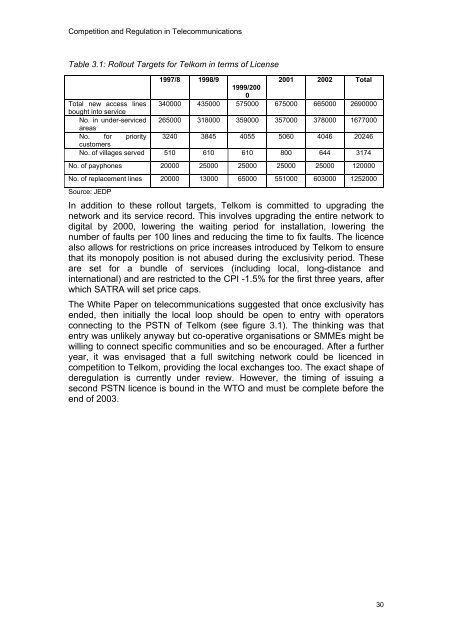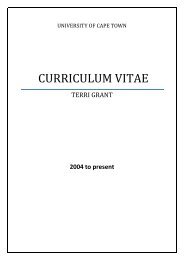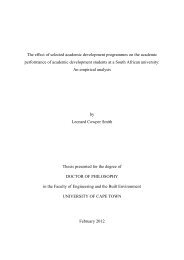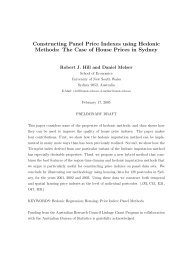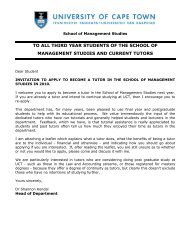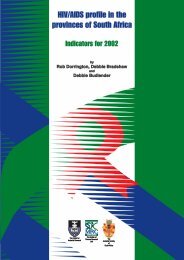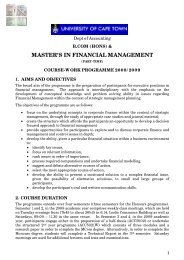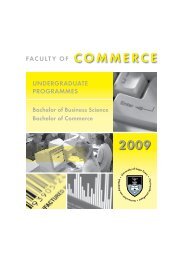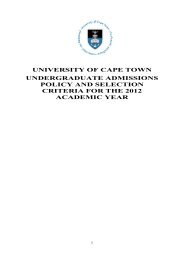Competition and Regulation in the Telecommunications Industry in ...
Competition and Regulation in the Telecommunications Industry in ...
Competition and Regulation in the Telecommunications Industry in ...
Create successful ePaper yourself
Turn your PDF publications into a flip-book with our unique Google optimized e-Paper software.
<strong>Competition</strong> <strong>and</strong> <strong>Regulation</strong> <strong>in</strong> <strong>Telecommunications</strong>Table 3.1: Rollout Targets for Telkom <strong>in</strong> terms of License1997/8 1998/92001 2002 Total1999/2000Total new access l<strong>in</strong>es 340000 435000 575000 675000 665000 2690000bought <strong>in</strong>to serviceNo. <strong>in</strong> under-serviced 265000 318000 359000 357000 378000 1677000areasNo. for priority 3240 3845 4055 5060 4046 20246customersNo. of villages served 510 610 610 800 644 3174No. of payphones 20000 25000 25000 25000 25000 120000No. of replacement l<strong>in</strong>es 20000 13000 65000 551000 603000 1252000Source: JEDPIn addition to <strong>the</strong>se rollout targets, Telkom is committed to upgrad<strong>in</strong>g <strong>the</strong>network <strong>and</strong> its service record. This <strong>in</strong>volves upgrad<strong>in</strong>g <strong>the</strong> entire network todigital by 2000, lower<strong>in</strong>g <strong>the</strong> wait<strong>in</strong>g period for <strong>in</strong>stallation, lower<strong>in</strong>g <strong>the</strong>number of faults per 100 l<strong>in</strong>es <strong>and</strong> reduc<strong>in</strong>g <strong>the</strong> time to fix faults. The licencealso allows for restrictions on price <strong>in</strong>creases <strong>in</strong>troduced by Telkom to ensurethat its monopoly position is not abused dur<strong>in</strong>g <strong>the</strong> exclusivity period. Theseare set for a bundle of services (<strong>in</strong>clud<strong>in</strong>g local, long-distance <strong>and</strong><strong>in</strong>ternational) <strong>and</strong> are restricted to <strong>the</strong> CPI -1.5% for <strong>the</strong> first three years, afterwhich SATRA will set price caps.The White Paper on telecommunications suggested that once exclusivity hasended, <strong>the</strong>n <strong>in</strong>itially <strong>the</strong> local loop should be open to entry with operatorsconnect<strong>in</strong>g to <strong>the</strong> PSTN of Telkom (see figure 3.1). The th<strong>in</strong>k<strong>in</strong>g was thatentry was unlikely anyway but co-operative organisations or SMMEs might bewill<strong>in</strong>g to connect specific communities <strong>and</strong> so be encouraged. After a fur<strong>the</strong>ryear, it was envisaged that a full switch<strong>in</strong>g network could be licenced <strong>in</strong>competition to Telkom, provid<strong>in</strong>g <strong>the</strong> local exchanges too. The exact shape ofderegulation is currently under review. However, <strong>the</strong> tim<strong>in</strong>g of issu<strong>in</strong>g asecond PSTN licence is bound <strong>in</strong> <strong>the</strong> WTO <strong>and</strong> must be complete before <strong>the</strong>end of 2003.30


